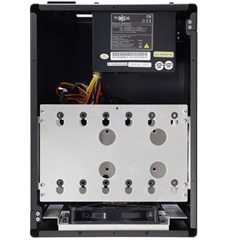Building an Iomega PX6 Replacement – Part Two
27th August 2011In part one I discussed how I didn’t want to splash out for an Iomega PX6 due to the poor cost performance figures I had seen for it. I had spent a long time before the PX4 and PX6 units actually shipped trying to decide whether to purchase a unit and in the end I decided against it. Having decided to self build a replacement for the Iomega PX6 I needed to decide on hardware, in part 1 I had already decided on the only mini-itx motherboard out there with 6 Sata3 ports on it, the Zotac M880G.
In part two we will look at case options for the PX6 Replacement unit.
Hardware Design Criteria
NAS Storage Case
The idea behind the self build NAS was that it had to be a capable replacement for the PX6 rather than the PX4, luckily for me I hadn’t planned on using six 3.5” drives but rather going for four spindle based drives and two SSD devices for my faster tiered storage (for VDI testing), with that in mind it wasn’t so important that the case actually had six full sized drive bays because the beauty of the SSD’s is that they can be stuck to the sides of cases and will still work just perfectly.
Looking around for storage cases showed that like my requirements for the motherboard there weren’t a great deal to offer, unlike the motherboard however there was more than just the choice of one ![]() .
.
Lian Li PC-Q08
The first case I looked at was the Lian Li PC-Q08
What we have with this case is the ability to hold six full sized drives in it and the fact that it comes from a well established and trusted vendor was a step in the right direction but the fact that it requires a full sized PSU was a bit of a let down (way too many wires and clearances could be an issue with the cabling for 6 drives needing to be routed properly.
For me a good case but in this instance not the right one for my project as this actually looks more like a gaming rig with the blue glow from the fan at the front, what I wanted was something that ‘looked’ like a NAS.
Cost range from £100 to £120 depending on which colour you want.
CFI A7879 NAS/Server Case
The next case up is the CFI-A7879 that I discovered over on the LinITX website.
Aimed at the NAS\Server market this was a case that offers four Hot Swappable front drive bays and utilises a 200W FlexATX power supply (Shuttle style PSU) and also offers a full height PCI slot at the rear of the case. It also offers an internal 2.5” mounting bracket so that I could mount a single SSD or using a Dual 2.5” SATA mounting card you could mount two SSD’s into the case. Unfortunately for me this case looks like it could suffer from internal space issues and there could be issues with routing cables and build up of heat due to the somewhat closed environment, so whilst offering some of the things I wanted this case still didn’t have that final ‘feel right’ factor.
Cost £89 for the case plus an additional £20.40 if you opt for the mounting card.
Fractal Design Array R2 NAS Case
The last case I looked at was from Fractal Design who are better known for their excellent cooling fan products, their decision to move into the case market has been the correct one from my perspective.
With the Array 2 NAS case we have a case that not only takes 6 drives internally but also has the looks of a decent NAS box, it has nice sharp lines and isn’t too over the top. Unlike the Lian Li this case also comes equipped with a 300W SFX based PSU. Size wise this case can fit both the Mini-ITX and Mini-DTX motherboards and comes equipped with a 140mm silent fan at the front of the case. There is plenty of space internally for cable routing and allows for a 90mm CPU cooler. The one downside for this case is the cost.
Costs range from £117.22 up-to an eye watering £152.18 and unfortunately trying to find it at the cheaper cost is VERY difficult to do.
As you can see there are definitely choices when it comes to cases, however there are some considerations to make if you’re restricted with space as you can see in the table below there are differences between all of the units mentioned (including the Iomega PX and IX units).
Obviously the choice is yours when it comes to cases but from my perspective I wanted a case that looked the part and for me that is the Fractal Design Array R2.
In the next part of this article I will cover building and initial testing of the unit with SATA 2 drives.









check out the lian-li q25